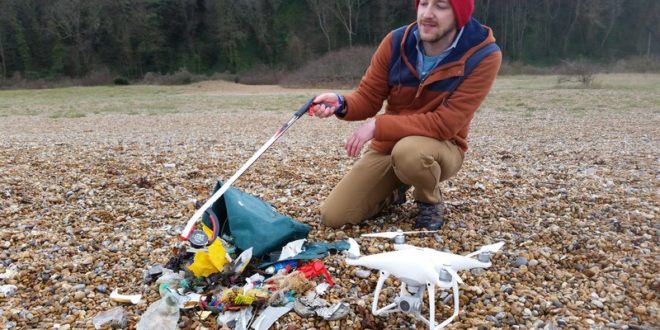An environmental group in England is utilizing drones and synthetic intelligence to assist measure plastic waste on the world’s seashores.
In the final 10 years, there was a 250% enhance of plastics washing up on the world’s seashores. Of the tens of millions of tons which might be dumped in our oceans every year, we will solely account for round 1%. The relaxation – sure, that’s 99% of tens of millions of tons – is lacking, misplaced among the many waves. That’s the startling introduction from The Plastic Tide founder Peter Kohler within the group’s intro video, beneath.
Having the noble intention of cleansing up the mess now we have made is simply the beginning. The scale of that process is monumental. Aside from all of the plastic floating round within the oceans and on the ocean ground, recognizing the waste that does flip up on seashores amongst pebbles and sand isn’t straightforward.
In an interview with DJI, The Plastic Tide outlined how they’ve been utilizing a mix of drones and machine studying to determine and measure the quantity of plastic waste on seashores. Eventually, the know-how might turn into an automatic aerial system, able to guiding cleanup efforts and monitoring their progress.
Penning an article for DJI, founder Peter Kohler explains how he began utilizing drones as a part of his ambition to clarify and perceive the unfold of plastic waste throughout our oceans. The essential problem was surveying seashores and gathering information in a manner that was quick, low cost and efficient.
Read extra: Drones Continue to Make an Impact in Marine Conservation
“Then it struck me,” he writes. “I could use drones! I had already seen the potential for drones in everything from filming to disaster relief. Cost effective, lightweight, quick to deploy, with powerful cameras and the ability to cover relatively large areas in minutes rather than hours. It seemed to be a great solution to the surveying problem.”
But drone imagery alone isn’t sufficient to quantify and acknowledge plastic waste, significantly in such a uniform atmosphere.
“It seemed like I needed a system that could learn what litter looked like, but I had no idea how to build that.”
It was in 2016 that Kohler started working with machine studying professional Dirk Gorissen. “To train the AI, we would need a large amount of images with litter tagged to teach the algorithm to find the plastics. This would mean a big exercise surveying as many different kinds of beaches as possible with a drone.”
The staff selected a DJI Phantom four and acquired to work, with somewhat assist from neighborhood volunteers.
“Volunteers worked to tag plastics in the images. This not only trained our algorithm, we found that many users reported that the process had made them much more aware of litter in the environment in general. We gathered 14,000 images from beaches across the UK and to date have collected of 4 million tags from over 10,000 volunteers – a humbling number!”
Read extra: Drones for Good: UNICEF is Calling on Drone Operators for Vaccine Delivery
And what concerning the future?
The wonderful thing about machine studying algorithms is that they’ll get smarter. The extra information they’re fed, the higher they turn into at recognizing photos.
So within the quick time period, The Plastic Tide needs to use the know-how to help and coordinate seashore cleansing efforts.
In the long run, Kohler writes, “we can target specific campaigns and policies to prevent our oceans from being polluted in the first place. Alongside this, we hope to share what we learn through this project, working to educate and engage the public in the importance of recycling.”
The charity plans to full various trials alongside coastlines this yr, primarily based on photos gathered from their drone working in seen gentle.
But maybe essentially the most thrilling potential brings us again to that statistic firstly, that solely round 1% of the plastic waste within the oceans finally ends up on our seashores.
Kohler writes that the staff “would like to explore the use of cutting-edge hyperspectral and multispectral imagery in combination with machine learning to extend the projects’ operational area from coastlines to the ocean’s surface and the sea floor.”
In simply 5 years he needs to be working not simply on coastlines, however on the ocean ground and on the floor of the water. Everywhere the unfold of plastic waste is damaging our surroundings.
You can learn extra about The Plastic Tide on their web site. The full characteristic for DJI is right here.
Malek Murison is a contract author and editor with a ardour for tech tendencies and innovation. He handles product critiques, main releases and retains an eye fixed on the fanatic marketplace for DroneLife.
Email Malek
Twitter:@malekmurison
 Unmanned Aerial Vehicle The latest drone news
Unmanned Aerial Vehicle The latest drone news


